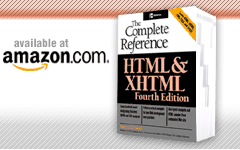Standard Character Entities
As discussed throughout the book, Web browsers do not render certain characters if they appear in an HTML document. Some keyboard characters such as < and > have special meanings to HTML because they are part of HTML tags. Other characters such as certain foreign language accent characters and special symbols can be difficult to insert as well. HTML uses a set of character entity codes in order to display these special characters. These codes consist of numbered entities and some, but not all, of these numbered entities have corresponding named entities. For example, the numbered entity Ë produces the character capital E with an umlaut. The named entity Ë produces the same character. Note that the named entity suggests the intended rendering of the character (a capital E with an umlaut), which provides a handy mnemonic device for dedicated HTML coders. While Ë is widely supported, not all character entities work in all browsers.
Theoretically, a browser vendor could even create arbitrary interpretations of these codes. For instance, some versions of MSN TV have their own unique renderings for the entities numbered 128 and 129. Under the traditional HTML specifications many of these, such as


